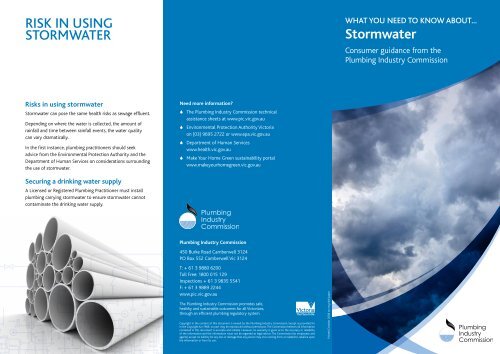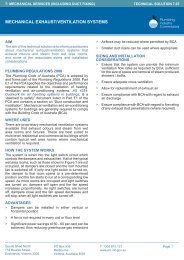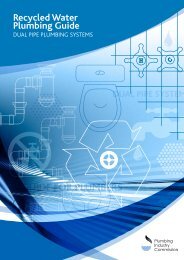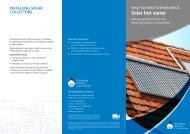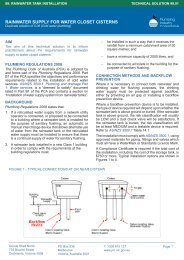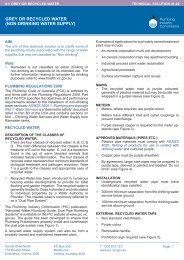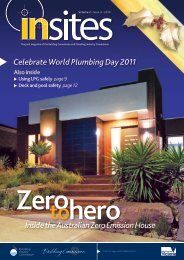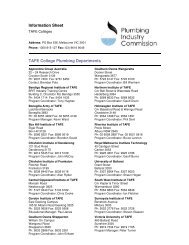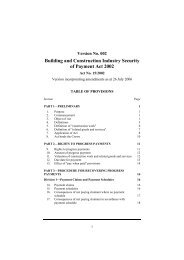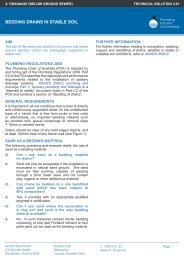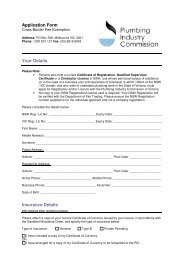Stormwater - Plumbing Industry Commission
Stormwater - Plumbing Industry Commission
Stormwater - Plumbing Industry Commission
You also want an ePaper? Increase the reach of your titles
YUMPU automatically turns print PDFs into web optimized ePapers that Google loves.
Risk in using<br />
stormwater<br />
What you need to know about...<br />
<strong>Stormwater</strong><br />
Consumer guidance from the<br />
<strong>Plumbing</strong> <strong>Industry</strong> <strong>Commission</strong><br />
Risks in using stormwater<br />
<strong>Stormwater</strong> can pose the same health risks as sewage effluent.<br />
Depending on where the water is collected, the amount of<br />
rainfall and time between rainfall events, the water quality<br />
can vary dramatically.<br />
In the first instance, plumbing practitioners should seek<br />
advice from the Environmental Protection Authority and the<br />
Department of Human Services on considerations surrounding<br />
the use of stormwater.<br />
Need more information<br />
S The <strong>Plumbing</strong> <strong>Industry</strong> <strong>Commission</strong> technical<br />
assistance sheets at www.pic.vic.gov.au<br />
S Environmental Protection Authority Victoria<br />
on (03) 9695 2722 or www.epa.vic.gov.au<br />
S Department of Human Services<br />
www.health.vic.gov.au<br />
S Make Your Home Green sustainability portal<br />
www.makeyourhomegreen.vic.gov.au<br />
Securing a drinking water supply<br />
A Licensed or Registered <strong>Plumbing</strong> Practitioner must install<br />
plumbing carrying stormwater to ensure stormwater cannot<br />
contaminate the drinking water supply.<br />
<strong>Plumbing</strong> <strong>Industry</strong> <strong>Commission</strong><br />
450 Burke Road Camberwell 3124<br />
PO Box 552 Camberwell Vic 3124<br />
T: + 61 3 9880 6200<br />
Toll Free: 1800 015 129<br />
Inspections + 61 3 9835 5541<br />
F: + 61 3 9889 2244<br />
www.pic.vic.gov.au<br />
The <strong>Plumbing</strong> <strong>Industry</strong> <strong>Commission</strong> promotes safe,<br />
healthy and sustainable outcomes for all Victorians,<br />
through an efficient plumbing regulatory system.<br />
Copyright in the content of this document is owned by the <strong>Plumbing</strong> <strong>Industry</strong> <strong>Commission</strong>. Except as provided for<br />
in the Copyright Act 1968, no part may be reproduced without permission. The <strong>Commission</strong> believes all information<br />
contained in this document is accurate and reliable. However, no warranty is given as to the accuracy or reliability<br />
of the information and the information must not be regarded as legal advice. The <strong>Commission</strong> (its employees and<br />
agents) accept no liability for any loss or damage that any person may incur arising from, or related to, reliance upon<br />
the information or from its use.<br />
Printed October 2008 on recycled paper
What is stormwater Collecting stormwater. Using stormwater.<br />
<strong>Stormwater</strong> is rainwater that falls on the ground or on paving,<br />
driveways or hard surfaces within a property, overflows from tanks<br />
and roof guttering. This water can be captured and pumped back<br />
for use.<br />
What can stormwater be used for<br />
<strong>Stormwater</strong> can carry a wide range of pollutants,<br />
including sediment, oil, hydrocarbons and leaves.<br />
As a result of this, stormwater can only be used for:<br />
S Toilet flushing<br />
S Sub-surface and surface irrigation.<br />
<strong>Stormwater</strong> must never be used for human<br />
consumption, washing, cleaning and cooking<br />
or mixed with water intended for such use.<br />
<strong>Stormwater</strong> should be used only where it has been captured solely<br />
from the user’s property, and where the property is clean, with no<br />
loose soil or chemical contamination (e.g. from petrol or diesel).<br />
When designing a stormwater capture and re-use project,<br />
a Licensed or Registered <strong>Plumbing</strong> Practitioner must consider:<br />
S collection systems<br />
S storage options<br />
S treatment requirements<br />
S distribution methods<br />
S the eventual use for the water<br />
S obtaining necessary approvals.<br />
Where possible, stormwater should not be<br />
stored in a device that is also used to store<br />
rainwater. However, if stormwater and<br />
rainwater are stored together, this water<br />
must only be used for low risk purposes<br />
such as garden watering and toilet flushing.<br />
As with any recycled water, it is important to match the<br />
intended use of stormwater with the quality of the water.<br />
Storage<br />
Where possible, stormwater should not be stored in a<br />
device that is also used to store rainwater. However, if<br />
stormwater and rainwater are stored together, this water<br />
must only be used for low risk purposes such as garden<br />
watering and toilet flushing.<br />
Additionally, stormwater and grey water should never be<br />
stored together. Untreated grey water should not be stored<br />
for more than 24 hours as it can turn septic. <strong>Stormwater</strong><br />
over flow can go back into the stormwater drainage system,<br />
while grey water over flow needs to be discharged into the<br />
sewerage system.<br />
Treatment<br />
<strong>Stormwater</strong> should always be treated before use. The risk<br />
of collecting contaminated water should be assessed at<br />
the outset when designing the stormwater re-use system.<br />
Generally, the more likely the water is to come into<br />
direct human contact, the more treatment and prevention<br />
is needed.<br />
<strong>Stormwater</strong> to be re-used for irrigation, for example, may<br />
need to be applied through sub-surface drippers rather<br />
than surface sprinklers, and you can not irrigate food crops.


